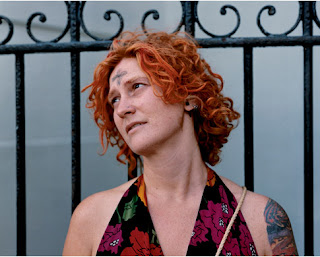Alec Soth began his talk in Marquette University
 |
| David Hockney Mother 1, Yorkshire Moors |
In his talk, Soth took up that last point directly, expressing his personal preference for situations in which he knows little about the subject he is photographing. He likes to project his own imagination onto them. This flies in the face of a conventional wisdom practiced by many photographers who often go to great lengths to know their subjects as intimately as possible. A personal favorite practitioner of this latter style is Mary Ellen Mark , who, for example, once spent three weeks living inside the maximum security section of a psychiatric hospital in order to establish personal relationships with the patients in Ward 81. Soth, by contrast, relishes brief interactions. The image below, which is in the exhibit, took 15 minutes, he said, and he knew nothing about the woman, except that on Ash Wednesday the mark on her forehead was made with cigarette ashes. Soth likes to create narratives, but he wants them to be his own ("artificially constructed") narratives. His subject is indeed a cipher for his point of view.
 |
| Alec Soth: Adelyn, Ash Wednesday |
The title of the show recalls "Mirrors and Windows," the legendary 1978 exhibit at the Museum of Modern Art by John Szarkowski (which I still remember seeing when it came to what was then called the Milwaukee Art Center!) Szarkowski identified two strains of photography: it can be a mirror, reflecting the mind of the photographer, or a window, through which one sees the external world. The exemplary collection of images in this exhibit seem to take a more nuanced position, to challenge the distinction between mirror and window. They are windows into a kind of reality, but one that can't be trusted to represent anything other than the artist's intentions.
 |
| Alec Soth Patrick, Palm Sunday |
"The Truth is not in the Mirror” continues through May 22. There will be a panel discussion about the exhibit next Wednesday, Feb. 2 at 6 pm. Additional programming and other information available at Haggerty Museum of Art.
With two runs already in, the lineup at the Haggerty makes it look like they will score again.
You write so well and help us understand the meaning behind this exhibit. Thank you. My 2 cents:
ReplyDeleteI just saw the exhibit this afternoon. Although it is exactly opposite of my style of photographing real people in their environment and not staging them, I found this exhibit to be very interesting. There are many ways to tell a story and Graham Miller's quote sums it up the best: "For me photography is much like writing - in the sense that you can approach it as fiction or non-fiction. Both are equally valid, and both are able to speak of the human experience in a moving and profound way."
These are very strong images and well worth seeing and contemplating.
I found interesting, and a little unbelievable, Soth’s comment that he prefers not to know his subjects. While he said he spent a mere 15 minutes photographing his “Ash Wednesday” woman, he had enough emotional rapport with her to seek her out some years later to photograph her again. Soth said he views his photos as blank slates upon which the viewer can project feelings. While that certainly may be true, his own action with the lady with the cigarette ash seems antithetical. His comment that he would like to walk up to a subject, not talk, shoot, and walk away sounds more theoretical than what he actually practiced. Having been crossed with ashes many times in my younger years, I certainly felt remembered emotions looking at Soth’s picture. His comments about not wanting to know his subjects triggered the memory of Georges Rouault’s famous clown – in storage at the Haggerty! – titled “Qui Ne Se Grime Pas?” (“Who does not wear a mask?”) If that’s the case, whether we want to or not, we really can’t know our subjects. Does anyone really know anyone? Soth’s photos and the “Mirror” exhibit at the Haggerty are not to be missed. Thanks, Eddee. – Dan Patrinos
ReplyDeleteProbably another article writer^
ReplyDeleteMiss tell
ReplyDelete